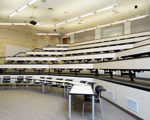The education methods used in today’s universities are rapidly changing, and as the methods change, so does the architecture. The big buzz right now is creating “collaborative spaces for learning“. Traditional push down models of teacher-to-student lectures are being supplemented by a new focus on interactivity and, there’s that buzz word again, collaboration. So what are the acoustical challenges inherent in the new system?
The basic tenant of collaboration is that there has to be clear communication between all parties. In the classroom or lecture hall it requires communication from teacher-to-student, student-to-teacher, and student-to-student communication. The latter being the greater design challenge.
Of issue is the idea of speech intelligibility. How can large lecture hall spaces be designed to maximize speech intelligibility and collaboration? Many designers are going to the semi-circle or even u-shaped desk configuration. While this immediately creates better eye contact between students, it can still create acoustical problems.
Acoustical design for classrooms and lecture halls is essential for creating a collaborative environment. Reflectors can be strategically added to maximize acoustical projection, acoustical absorbing treatment can reduce unwanted reverberation, and diffusers can scatter the sound to give the room a lively feel. The end result is an environment optimized for learning, and especially collaboration.
Don’t wait until your new school is built to think about classroom acoustics. Get an acoustical consultant who understands schools and education, and get them on board early. Make sure your school addresses the new buzz and is equipped to face future educational changes.
